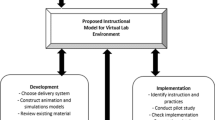Abstract
In general, students of laboratory courses such as chemistry or biology are not able to replicate at home an experiment of a previously studied class since they lack infrastructure and material. With the possibility of providing multimedia and virtual reality environments on the Web, different applications and virtual laboratories have been proposed. However, most of the existing tools are not flexible enough or are domain-oriented, not supporting the addition of new tailor-made experiments when needed. This paper introduces a new platform for providing a customizable Virtual Laboratory, VirtualLabs@UMa. This application was proposed at University of Madeira in order to provide students with a flexible 3D virtual laboratory and teachers with a platform that can be customized to new experimental protocols. Therefore, chemistry teachers are able to create their own experimental protocols and propose them to their students. Moreover, students can be followed accordingly having their learning needs and difficulties fulfilled. VirtualLabs@UMa is a solution for motivating students and proposing an added value for complementing laboratory courses.




















Similar content being viewed by others
References
Autodesk (2010) Autodesk 3ds Max Products. On November 8th 2010, from http://usa.autodesk.com/adsk/servlet/pc/index?siteID=123112&id=13567410
Banerjee K (2010) Utilising the virtual laboratory resources for incorporating ICT in the chemistry teacher education. In: proceedings of 6th Pan-Commonwealth Forum on Open Learning. 24th–28th November, Kochi, India
Bredemeyer D, Malan R (2004) “What It Takes to Be a Great Enterprise Architect.” Cutter Consortium Enterprise Architecture Executive Report, Vol. 7, No. 8, 2004. from http://www.cutter.com/offers/greatarchitect.html
ChemLab—A Virtual Chemistry Lab. URL: http://modelscience.com/
Domingues L, Rocha I, Dourado F, Alves M, Ferreira EC (2010) Virtual laboratories in (bio)chemical engineering education. Journal of education for chemical engineers 5:e22–e27
Fowler M (2003) Catalog of Patterns of Enterprise Application Architecture. URL: http://martinfowler.com/eaaCatalog/index.html
Gamma E, Helm R, Johnson R, Vlissides J (1995) Design patterns: elements of reusable object-oriented software. Addison-Wesley, Reading
Google Code (2010) O3D WebGL implementation of O3D. On November 2010, from http://code.google.com/p/o3d/
GuangChun L, Lu W, Hanhong X (2003) A novel Web Application frame developed by MVC, ACM SIGSOFT Software Engineering Notes
Howard Hughes Medical Institute (2010) BioInteractive Virtual Labs. On November 8th 2010, from http://www.hhmi.org/biointeractive/vlabs/
Malan R, Bredemeyer D (2009) Functional Requirements and Use Cases. Bredemeyer Consulting - White Paper. 8/3/01 On November 8th 2010, from http://www.bredemeyer.com/use_cases.htm
Mendonça RFP (2010) VirtualLabs@Uma: A customizable platform for experimental activities. M.Sc. Dissertation. University of Madeira. November, 2010
Moodle (2010) Moodle.org:About. On November 8th 2010, from http://moodle.org/about/
Morales-Chaparro R, Linaje M, Preciado JC, Sanchez-Figueroa F (2008) MVC Web design patterns and Rich Internet Applications, Quercos Software Engineering Group, Universidad de Extremadura
Morse SF, Anderson CL (2004) Introducing application design and software engineering principles in introductory CS courses: model-view-controller Java application framework. J Comput Sci Coll 20(2)
Mozilla (2010) Web Development Evolved. On November 8th 2010, from http://getfirebug.com/
Net Pedagogy Portal (2006) The Evolution of Internet Pedagogy. On April 2012, from http://www.thewebworks.bc.ca/netpedagogy/Evolution/evolution.html
Network for education-chemistry: chemgapedia. URL: http://www.chemgapedia.de/vsengine/topics/en/vlu/index.html
O’Keeffe J Definition of Experimental Protocol. eHow website. URL: http://www.ehow.com/facts_7176350_definition-experimental-protocol.html
Oberg R, Probasco L, Ericsson M (2010) Applying Requirements Management with Use Cases. Rational Software—Technical Paper TP505. On November 8th 2010, from http://www.wthreex.com/rup/papers/pdf/apprmuc.pdf
OGRE—Open Source 3D Graphics Engine (2001) http://www.ogre3d.org/
Open Learning Initiative—OLI. Carnegie Mellon University. URL: http://oli.web.cmu.edu/openlearning/
Paolini P, Garzotto F, Bolchini D, Valenti S (1999) Modelling by Pattern of Web Applications, Int. Workshop on the World-Wide Web and Conceptual Modeling
Pirelli (2010) Pirelli International Award. On November 8th 2010, from http://www.pirelliaward.com/ed7_tpp.html
Rodello IA, Sakai RK, Manoel EF (2002) Um Ambiente Virtual para Auxiliar o Ensino de Química em Escolas de Ensino Fundamental. In: WIE 2002—VIII Workshop de Informática na Escola, Florianópolis. XXII Congresso da Sociedade Brasileira de Computação. Porto Alegre: SBC, 2002. v. 1
sas. Concepts of Experimental Design. Design Institute for Six Sigma. White Paper. URL: http://support.sas.com/resources/papers/sixsigma1.pdf
Sauter P, Vögler G, Specht G, Flor T (2005) A Model–View–Controller extension for pervasive multi-client user interfaces, personal and ubiquitous computing. Springer-Verlag
The Eclipse Foundation (2010) Eclipse. On November 8th 2010, from http://www.eclipse.org/
Van Someren MW, Barnard YW, Sandberg JAC (1994) The think aloud method—a practical guide to modelling cognitive processes. Department of Social Science Informatics, University of Amsterdam. Academic, London, ISBN 0-12-714270-3
VirtLab—A Virtual Chemistry Laboratory. URL: http://chemistry.dortikum.net/en/
Virtual Chemistry–Virtual Laboratories. URL: http://www.chem.ox.ac.uk/vrchemistry/
Virtual Molecular Science Laboratory on the Grid—VMSLab-G. University of Perugia, Perugia, Italy. URL: http://www.vmslab.org/
VirtualLab Pearson. URL: http://www.labsvirtuais.com.br/
virtualLaboratory.net,inc (2009) Virtual Laboratories—socratic stimulators. On November 8th 2010, from http://virtuallaboratory.colorado.edu/
W3C (2010) Extensible Markup Language (XML). On November 8th 2010, from http://www.w3.org/XML
Web3D (2010) X3D Developers. On November 2010, from http://www.web3d.org/x3d/
Web3D Consortium (1995) The Virtual Reality modeling Language Specification. On November 8th 2010, from http://www.web3d.org/x3d/specifications/vrml/VRML1.0/
Woodfield BF, Andrus MB (2006) Virtual ChemLab—organic synthesis and qualitative analysis v2.5. Prentice Hall, ISBN: 0132388278
Yaron D, Karabinos M, Lange D, Greeno JG, Leinhardt G (2010) The ChemCollective—virtual labs for introductory chemistry courses. Science Magazine 328:584–585
Author information
Authors and Affiliations
Corresponding author
Rights and permissions
About this article
Cite this article
Sampaio, P., Mendonça, R. & Carreira, S. Learning chemistry with VirtualLabs@Uma: a customizable 3D platform for new experimental protocols. Multimed Tools Appl 71, 1129–1155 (2014). https://doi.org/10.1007/s11042-012-1260-4
Published:
Issue Date:
DOI: https://doi.org/10.1007/s11042-012-1260-4




